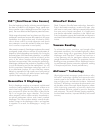
10 Placement & Room Acoustics
your speaker slightly forward into the room. What hap-
pened to the bass response? What happened to the
imaging? If the imaging is more open and spacious and
the bass response is tightened, that is a superior posi-
tion. Move the speakers back six inches from the initial
setup position and again listen to the imaging and bass
response. There will be a position where you will have pin-
point imaging and good bass response. That position is
the point of the optimal placement from the front wall.
Now experiment with placing the speakers farther apart.
As the speakers are positioned farther apart, listen again,
not so much for bass response but for stage width and
good pinpoint focusing. Your ideal listening position and
speaker position will be determined by:
• Tightness and extension of bass response
• Width of the stage
• Pinpoint focusing of imaging
Once you have determined the best of all three of these
considerations, you will have your best speaker location.
The Extra “Tweak”
This extra “tweak” may be useful when your speakers are
placed in a dedicated listening room. Use the following
procedure and measurements for your speakers placement
to see what can happen to your system’s performance.
These formulas will help determine optimum placement of
your speakers to minimize standing waves.
1 Distance from the front wall (in front of the listening
position) to the center of the curvilinear transducer: To
determine distance from the front wall, measure the
ceiling height (inches) and multiply the figure by 0.618
(i.e. ceiling height (inches) x 0.618 = the distance from
the front wall to the center of the curvilinear transducer).
2 Distance from the side-walls to the center of the curvi-
linear transducer: To determine distance from the side
walls, measure the width of your room in inches and
divide by 18. Next, multiply the quotient by 5 (i.e.
room width in inches / 18 x 5 = the distance from the
side-walls to the center of the curvilinear transducer).
Your Room
This is one of those areas that requires both a little back-
ground to understand and some time and experimentation
to obtain the best performance from your system.
Your room is actually a component and an important part
of your system. It can dramatically add to, or subtract
from, a great musical experience.
All sound is composed of waves. Each note has its own
wave size, with the lower bass notes literally encompassing
from 10’ feet to as much as 40’ feet. Your room partici-
pates in this wave experience like a three dimensional pool
with waves reflecting and becoming enhanced depending
on the size of the room and the types of surfaces in the room.
Remember, your audio system can literally generate all of
the information required to recreate a musical event in time,
space, and tonal balance. Ideally, your room should not
contribute to that information. However, every room does con-
tribute to the sound to some degree. Fortunately MartinLogan
had designed the Purity to minimize these anomalies
Terminology
Standing Waves
The parallel walls in your room will reinforce certain notes
to the point that they will sound louder than the rest of
the audio spectrum and cause “one note bass”, “boomy
bass” or “bloated bass”. For instance, 100Hz represents a
10 feet wavelength. Your room will reinforce that specific
frequency if one of the dominant dimensions is 10 feet.
Large objects in the room such as cabinetry or furniture
can help to minimize this potential problem. Some serious
“audiophiles” will literally build a special room with no
parallel walls just to help eliminate this phenomenon.
Reflective Surfaces (near-field reflections)
The hard surfaces of your room, particularly if close to your
speaker system, will reflect some waves back into the room
over and over again, confusing the clarity and imaging of
your system. The smaller sound waves are mostly affected
here, and occur in the mid and high frequencies. This is
where voice and frequencies as high as the cymbals occur.
Resonant Surfaces and Objects
All of the surfaces and objects in your room are subject to
the frequencies generated by your system. Much like an
instrument, they will vibrate and “carry on” in syncopation
with the music, and contribute in a negative way to the
music. Ringing, boominess, and even brightness can occur
simply because they are “singing along” with your music.
Resonant Cavities
Small alcoves or closet type areas in your room can be
chambers that create their own “standing waves” and can
drum their own “one note” sounds.
Clap your hands. Can you hear an instant echo respond


















